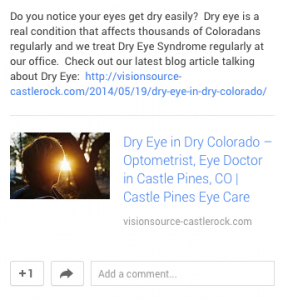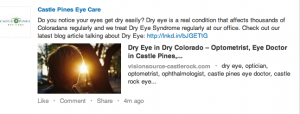The latest blog article for Castle Pines Eye Care is up! We were honored to research, ghost write, and promote on social media this blog article for a great eye doctor in South Denver!
Check it out!
Dry Eye in Dry Colorado
It’s dry here in Colorado! This means more lotion, more chap stick, and more eye drops! Dry eye is a condition where the eye lacks sufficient tears to lubricate and nourish the eye. Tears are essential for maintaining a healthy eye surface and providing clear vision. While dry eye can occur in patients who live anywhere, in Colorado we see dry eye syndrome as a more common condition.
How Does Dry Eye Occur?
Dry eye occurs from an improper balance of tear creation and drainage. One of the main causes is simply an inadequate production of tears. Tears are produced by several glands near and in the eyelids. Tear production can diminish for a number of reasons. Dry eye can also develop from poor quality of the tears an eye is producing. Tears are made up of three layers: oil, water, and mucus. Each layer is essential in nourishing the front surface of the eye. When part of that component is lacking, the tear may evaporate too quickly, or not spread evenly across the cornea.
What Causes Dry Eye?
- Age—dry eye is a part of the natural aging process. Many people over age 65 experience some dry eye symptoms.
- Gender—women are more likely to develop dry eyes due to hormonal changes caused by pregnancy, the use of oral contraceptives, and menopause.
- Medications—certain medicines, including antihistamines, decongestants, blood pressure medications and antidepressants, can reduce the amount of tears produced in the eyes.
- Medical conditions—persons with rheumatoid arthritis, diabetes and thyroid problems are more likely to have symptoms of dry eyes. Also, problems with inflammation of the eyelids (blepharitis), inflammation of the surfaces of the eye, or the inward or outward turning of eyelids can cause dry eyes to develop.
- Environmental conditions—exposure to smoke, wind and dry climates can increase tear evaporation resulting in dry eye symptoms. Failure to blink regularly, such as when staring at a computer screen for long periods of time, can also contribute to drying of the eyes.
Other factors—long term use of contact lenses can be a factor in the development of dry eyes. Refractive eye surgeries, such as LASIK, can cause decreased tear production and dry eyes.
How is Dry Eye Treated?
There are a variety of treatments to dry eyes. One simple approach is adding tears with artificial tear solutions, including over the counter and prescription eye drops. Another technique that is effective is blocking tear ducts so that tears remain in the eyes longer. There are also prescription eye drops that can help increase the amount of tears you produce. There are a variety of treatments for dry eye and it is best to discuss with your doctor what treatment is best for you. At Castle Pines Eye Care, we regularly care for dry eye in our patients and understand the needs of this condition here in Colorado.
Reference Articles: http://www.aoa.org/patients-and-public/eye-and-vision-problems/glossary-of-eye-and-vision-conditions/dry-eye?sso=y




